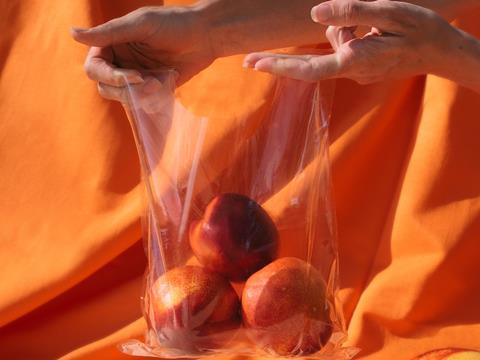
Sway, a start-up that produces home-compostable film materials made from seaweed, recently won the prestigious Tom Ford Plastic Innovation Prize. We spoke with the company to learn more about its funding journey, how its solutions compare to conventional alternatives in terms of functionality and sustainability, and what the future of the seaweed packaging industry might look like.
What is Sway and could you give us a brief history of the company? It would be great if you could reveal some insights into the early days, R&D, and how you gained funding.
Sway is a cleantech startup scaling seaweed-based, rapidly compostable plastic replacements. Our products are optimized for compatibility with existing machinery, integrating seamlessly into traditional plastic manufacturing infrastructure for ease of adoption. After use, our packaging decomposes in both home and industrial compost environments, producing healthy soil while simultaneously replenishing the social and ecological systems harmed by petroleum plastics.
A brief history:
- 2018: A lifelong environmentalist and designer by trade, Julia Marsh is frustrated by the limitations of plastic alternatives. She discovers seaweed can be transformed into plastic-like materials, and begins experimenting in a makeshift lab (aka her kitchen) to create her own cups, plates, and straws.
- 2019: Julia unites forces with sustainable development expert Matt Mayes and renowned brand creator Leland Maschmeyer to conceptualize Sway. Julia and Matt travel the world to learn from seaweed farmers and biomaterial innovators.
- 2020: A team is assembled, harnessing talent from industry experts and advisors representing major CPGs, seaweed PhDs, materials science experts, and compost alliances. Together, they create a prototype that wins the Beyond the Bag Challenge and gains acceptance to the Sustainable Ocean Alliance accelerator.
- 2021: We close a first fundraise of $2.5M and expand our team, supplier base, and potential customer network. Sway products undergo rapid iteration through labs, compost certification bodies, and retailers like Target, Walmart, and CVS. Our team designs formulations that unlock commercial potential.
- 2022: Sway gains global recognition, appearing at major packaging and sustainability conferences around the world. Our solution is chosen as a TOM FORD Plastic Innovation Prize finalist, followed by a year under rigorous testing across vital scale, cost, performance, biological degradation, and environmental & social impact criteria.
- 2023: Marking a major milestone in March, Sway wins 1st place in the TOM FORD Plastic Innovation Prize. Sway enters the Innovation Accelerator this June, sponsored by TOM FORD Beauty and Estée Lauder companies, to scale our product. In tandem, we launch our flagship product to the public through pilots with innovation partners, Graf Lantz, Ales Grey, and more. We plan to close our next round this summer, allowing us to grow our team, expand our lab, and scale our products to meet commercial demand.
What functions and formats is Sway most suited for?
Our current focus is flexible, thin-film packaging suited for use as polybags, pouches, or product windows for fashion, home goods, and food. Our 100% Biobased Certified film is majority seaweed, flexible, durable, and seat-sealable with low permeability to air and oil. Additionally, it can be customized in terms of color, transparency, and texture.
We are piloting our flagship material in limited activations through a select group of innovation partner brands committed to testing, iterating, and helping us improve our product for expanded market fit.
How does it compare to traditional alternatives from a sustainability/emissions perspective? Have you undertaken any LCAs?
Plastic is responsible for significant greenhouse gas emissions at every phase of its life, from extraction and transport to refining and manufacturing to waste management and pollution in the environment.
Sway packaging shifts demand away from greenhouse gas-intensive fossil fuels and toward a renewable resource instead: seaweed. Seaweed also enables us to reduce emissions; unlike land crops, seaweed farms are not carbon-intensive to cultivate. They don’t require arable land, freshwater, or fertilizer to grow.
New scientific studies even suggest that seaweed farms can store substantial amounts of living and sequestered carbon. Their added benefits to ecological and social systems are abundant: responsible cultivation of seaweed purifies water, enhances biodiversity, reverses ocean acidification, and secures climate-resilient employment for coastal communities as warming waters affect harvests.

How do you plan to scale Sway and make it widely available on a commercial level, and, in general, what will it take to make solutions like this more mainstream?
We are thrilled to share that we are currently running public pilots with key innovation brands like Graf Lantz and Ales Grey, with more launching soon. These limited-edition campaigns are designed for Sway to gain valuable end-user feedback and shape an enabling environment for our products as they become more widely available.
Building from the results of the pilots, Sway is planning for a larger-scale launch with outdoor, apparel, and food brands in both retail and e-commerce applications. In tandem, we will expand our product offering in partnership with a small selection of strategic brand partners.
Behind the scenes, manufacturing plays a huge role in the ability for biomaterial innovations like ours to scale. Winning first place in the TOM FORD Plastic Innovation Prize this year was an enormous milestone for Sway, publicly validating our capacity to meet stringent standards on scale, cost, performance, degradation, and impact.
All of these criteria generate excitement and trust among a broader network of manufacturers and brands who are eager to adopt sustainable packaging solutions, helping bridge relationships and earn precious line time with industry-leading packaging manufacturers.
If solutions like this did become more mainstream, how would this affect the global seaweed farming industry? What can be done to ensure that these processes are sustainable?
The growth of a thriving, regenerative seaweed economy is not inevitable. Without close attention to its ecological impact, seaweed cultivation can bring negative results like marine eutrophication, in which there’s a harmful excess of nutrients; diseases that can spread to wild seaweed populations; and genetic alterations caused by monocropping. As in any industry, the prominence of “middlemen” and monopoly groups can also reduce the economic benefits to coastal communities.
To foster the growth of regenerative ocean farming and unlock the true potential of seaweed cultivation as a climate solution, investors need to distribute funds throughout the value chain in the following areas:
1. More research. Virtually any scientific publication on seaweed cultivation includes a laundry list of data gaps and further research questions. To pursue seaweed sustainably, we must have a robust understanding of its ecological risks and benefits as well as best practices. From there, we must set clear standards for regenerative ocean farming and integrate seaweed farms into marine planning in a way that promotes conservation and respects ecological limitations and carrying capacities.
2. Proper regulation. While Maine has led the way on ecologically driven regulation in the United States, offering a comprehensive but robust permitting process, other states have not. Guided by science, regulators must ensure that seaweed economies can grow — and grow responsibly.
3. Community. Regenerative ocean farming needs engagement between product innovators, farmers, regulators, conservation organizations, researchers, and seaweed’s many other stakeholders. Through community — including all the debate and disagreement that comes with it — we will work toward a shared vision of seaweed aquaculture and an agenda to actualize that vision.
If you liked this article, you might also enjoy:
The Lidl approach to packaging sustainability
How did Brazil achieve its 100% aluminium can recycling rate – and can it be replicated in the EU?
Experts have their say on the EU’s Packaging and Packaging Waste Directive revisions
A deep dive into the most important packaging sustainability trends and solutions





















No comments yet